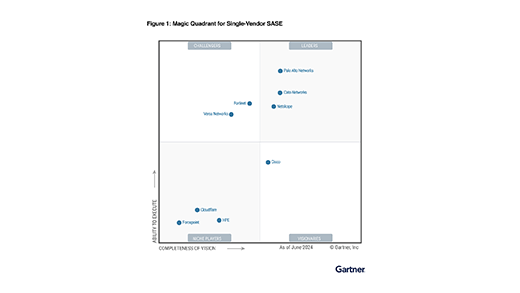Let’s face it, your remote connectivity architecture isn’t going to cut it for much longer. Maybe you struggle with providing uniform secure optimized access, or with a patchwork of multi-vendor policies, or with network blind spots across all remote users, devices, sites, and clouds. One or all of these issues can lead to a situation that would significantly impact digital business operations. Fortunately, there’s a better way. Netskope Borderless SD-WAN offers an architecture that converges zero trust principles and assured application performance to provide unprecedented secure, high-performance connectivity for every site, cloud, remote user, and IoT device..
A storm is brewing at the corporate edge
To understand why Borderless SD-WAN is needed, we must first remember where we’ve come from.
One-to-one connectivity: In the early 2000s, enterprises backhauled all traffic from a branch office to data centers, typically over a dedicated MPLS link in a one-to-one connectivity model.
One-to-many connectivity: As the number of applications grew and applications migrated to the cloud, those routing paths became ever more nonsensical. SD-WAN came onto the scene, augmenting MPLS with high-bandwidth inexpensive internet links, allowing users in branches to connect directly to distributed on-premise and SaaS applications rather than circuitously routing all traffic through the enterprise network.
Many-to-many Connectivity: Today, we have entered a new era of borderless enterprise in which users, devices, sites, and clouds are all connected in numerous ways. We have a remote-first perspective and have moved beyond the four walls of the traditional corporate office. The growth of micro-branches, multi-cloud, remote-work, telehealth, mobile fleet, and IoT assets in manufacturing, are examples of how the perimeter has expanded. The momentum and direction are clear, but in this era, legacy network architectures are lagging and weighing us down. The enterprise network was never designed for this world. It requires a rethinking of how we build the modern network, that allows for networking and security to tightly integrate, security delivered from the cloud based on zero trust principles—this is what Gartner called secure access services edge (SASE).
Simply put, existing networking and security technologies that have been shoehorned into enterprise infrastructures. They either create, or simply aren’t built to overcome, the following challenges.
- You can’t patch your way to a better network: Many IT architects are now grappling with having to manage multiple point-based remote connectivity solutions like remote access, SD-WAN, Wireless WAN, or multi-cloud deployments that often underperform and lack centralized management and visibility. These disparate technologies are forced to work together, often proving to be overly complicated from both an end-user and ITOps perspective. Fragmented architecture results in an inability to apply uniform security or quality of experience (QoE) policy across all users, devices, sites, and clouds. Companies end up spending a great deal of physical and financial resources to make this hodgepodge functional. When managing multiple technology platforms for zero trust access, network/data security, and application performance, end-to-end visibility gaps undoubtedly form. This lack of visibility exacerbates maintenance processes and increases the amount of time and effort required to identify and resolve cybersecurity and performance related incidents.
- You can’t prioritize or secure what you can’t discover: Apps and IoT device proliferation matters now more than ever. Traditional SD-WAN supported a few thousand applications, which served it well at the time, but the sheer volume of cloud applications and IoT devices has since exploded. Enterprises need solutions that provide visibility and control over tens of thousands of apps and devices. IT architects require simplicity, so they are not configuring these apps one at a time, as that is simply not scalable. Further, lack of visibility and granular control of IoT poses risks to the network. For this, fine-grained AI/ML-driven segmentation is required rather than traditional VLAN-based segmentation.
- You need to acknowledge that “good enough” security wasn’t built to last: Traditional SD-WAN allowed branches to communicate directly over the internet to multiple clouds, opening a gaping security hole in the process. Some enterprises opted for distributed security at each site which was complex to manage and scale. SD-WAN vendors started throwing around the word “good enough security” at the branch level. “Good-enough” network security is no substitute for the best-in-breed security you get with SASE. Time has proven that cloud-delivered security is the right approach. Single vendor SASE enables unified architecture with simplification and context sharing between SD-WAN and cloud delivered security.
- You must bring cloud, network, and security together: Organizations are experiencing immense frustration when it comes to connecting users, devices, and sites to the cloud, multiple clouds, due to the overwhelming complexity of cloud networking. Architecture needs to evolve so that security, speed, and network optimization is built-in and an essential part of connectivity, not a bolted-on afterthought. Use cases could range from a user getting secure, optimized access to on-prem or cloud apps over unreliable internet or branches that are globally distributed and are trying to access apps across unreliable mid-mile or multi-cloud app-to-app connectivity with security.
- You can’t build yet another “fat” SD-WAN architecture, it is a thing of the past: Network is moving to the cloud and compute closer to the edge. Many SD-WAN vendors started on the path of service chaining SD-WAN VM with on-prem partner Security VM on a large appliance. However, a lot of the security and networking functions have moved to the cloud. What has changed though, is the requirement to have lightweight compute functions closer to the data source. More containerized applications are being deployed at the network edge and this creates significant application management challenges that current “fat” SD-WAN architectures are not built for. These apps could enable different use-cases. As an example, a retailer that wants a POS system to be available 100% of the time, would move the PoS system onto their edge compute to maintain high availability, or it could be a manufacturing app that pre-aggregates sensor data instead of streaming all data over cellular which easily becomes cost prohibitive or simply run an app like Thousandeyes to eliminate appliance sprawl.
At some point, the lack of assured application experience or uniform security, visibility and application management creates a breakdown, causing users and devices to be unable to access remote resources with the proper level of performance or cybersecurity policy. So, what’s an IT architect supposed to do?
Say hello to Netskope Borderless SD-WAN
Netskope Borderless SD-WAN is a 100% SaaS-based, converged remote connectivity platform that strikes to the heart of what most enterprises lack today: one platform, one software, and one policy for multiple deployments. Combined into a unified architecture, these components deliver secure, reliable access for all remote users, sites, and devices to on-premises services, as well as the most popular enterprise SaaS and cloud-based applications. With simplified management and tight integration of Netskope Borderless SD-WAN and Netskope Intelligent SSE, much of the heavy lifting is already taken care of and you can bring all of your remote users, devices, sites, and multi-cloud environments online in minutes–all with consistent network and security policy.
Netskope Cloud XD is the “engine” that enables zero trust principles. Cloud XD decodes thousands of apps, understands the app risk, and detects IoT devices using ML, as well as device risk, users, and user risk. Netskope Borderless SD-WAN powered by Netskope Cloud XD provides granular, context-aware adaptive policies to deliver uniform security and QoE. Netskope Borderless SD-WAN also makes it easier to run custom third-party applications at the network edge for real-time processing or simply for box consolidation. Netskope’s SASE, is built on a fast, reliable, and a converged, cloud-native platform called NewEdge with the most coverage in the industry (67 regions) and single-digit millisecond latency for the vast majority of the world’s knowledge workers. The result is a new way forward for connectivity, one built in the cloud, that delivers incredible business agility.

With Borderless SD-WAN, brighter days are ahead.
Securing and optimizing connectivity for users, sites, and devices to enterprise and cloud resources doesn’t have to be difficult. All it takes is the right strategy and the right platform. If you’re looking to migrate away from your current fragmented architecture because it’s become too cumbersome to manage or no longer meets your needs, you’ve come to the right place. Look to Netskope’s Borderless SD-WAN architecture to deliver consistent zero trust security and application performance for your borderless enterprise.
We have much to tell you in the coming weeks about Borderless SD-WAN and how we’re continuing to enhance what we can offer. In the meantime visit the Netskope Borderless SD-WAN page and watch our on-demand webinar “Accelerate your SASE Journey with Netskope Borderless SD-WAN”, in the Netskope Community.
Click here to contact a Netskope sales partner if you would like to arrange an Borderless SD-WAN demo.




 Zurück
Zurück 
















 Den Blog lesen
Den Blog lesen